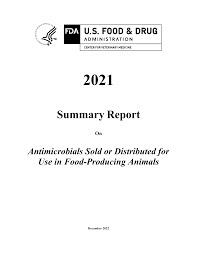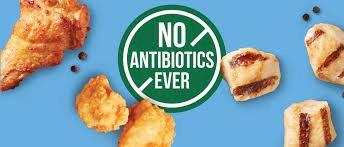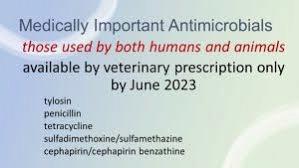 In late December 2022, the FDA published a summary report on veterinary antibiotic use entitled Antimicrobials Sold or Distributed in 2021 for Use in Food-Producing Animals. The report should be considered in light of Guidance for Industry Documents #2 & #3 and #152 which classified antibiotic classes as either medically important for human therapy or not medically important including ionophore antibacterials. It is also noted that in 2017 veterinary feed directives (VFDs) or prescriptions were required for food additive or water administered antibiotics respectively. The executive summary of the report demonstrated a decrease of 33 percent in antibiotic use from 2012 through 2021 but a decrease of less than one percent from 2020 through 2021 suggesting a plateau. With specific reference to 2021, for all food species tetracyclines accounted for 35 percent, penicillins for 6 percent, macrolides for 5 percent, sulfas and aminoglycosides 3 percent each, lincosamides for 2%, cephalosporins for 0.2 percent. Fluoroquinolones use accounted for less than 0.2 percent consistent with the two-decade ban on this class of antibiotics.
In late December 2022, the FDA published a summary report on veterinary antibiotic use entitled Antimicrobials Sold or Distributed in 2021 for Use in Food-Producing Animals. The report should be considered in light of Guidance for Industry Documents #2 & #3 and #152 which classified antibiotic classes as either medically important for human therapy or not medically important including ionophore antibacterials. It is also noted that in 2017 veterinary feed directives (VFDs) or prescriptions were required for food additive or water administered antibiotics respectively. The executive summary of the report demonstrated a decrease of 33 percent in antibiotic use from 2012 through 2021 but a decrease of less than one percent from 2020 through 2021 suggesting a plateau. With specific reference to 2021, for all food species tetracyclines accounted for 35 percent, penicillins for 6 percent, macrolides for 5 percent, sulfas and aminoglycosides 3 percent each, lincosamides for 2%, cephalosporins for 0.2 percent. Fluoroquinolones use accounted for less than 0.2 percent consistent with the two-decade ban on this class of antibiotics.
In evaluating medically important antibiotic drugs approved for use in food-producing animals actively marketed in 2021, a total of 5,115,111 kg was used in cattle, swine, chicken and turkey production combined. The “other” category for nonfood-producing animals and minor food-producing species including aquaculture were subtracted from the total of 5,989,721 kg. Chicken (presumed to be broilers) consumed 2.6 percent of the total non-medically important drugs amounting to 158,342 kg. Turkeys consumed 11.0 percent of the antibiotics used in food-producing animal. The use of antibiotics in egg production is negligible and for the purposes of the FDA report was in all probability included in the “chicken” category.
 To determine relative use of antibiotics in chickens and turkeys and the difference between broilers and turkeys during 2016 and 2021, the respective use rates expressed as mg per kg RTC were calculated for the two segments of the poultry meat industry. For ‘chickens’, (presumably broilers) each kg of RTC product used the equivalent of 0.028g (28mg) of antibiotic in 2016. Use per kg of RTC declined by 72.1 percent to 0.0078g (7.8mg) in 2021. This is consistent with the general perception that antibiotic use in the broiler industry has declined sharply over the past five years due to the introduction of ‘no antibiotic ever’ production and a general disinclination to administer antibiotics. For turkeys, the consumption of antibiotic expressed per unit of mass was 0.278 g (278mg) per kg in 2016 with a 6.1 percent reduction to 0.261g (261mg) per kg RTC in 2021. Between 2018 and 2021 the ratio of antibiotic use between turkey and chicken production widened from 9.9 to 33.4 suggesting less progress in eliminating antibiotics for the turkey segment of the U.S. poultry industry.
To determine relative use of antibiotics in chickens and turkeys and the difference between broilers and turkeys during 2016 and 2021, the respective use rates expressed as mg per kg RTC were calculated for the two segments of the poultry meat industry. For ‘chickens’, (presumably broilers) each kg of RTC product used the equivalent of 0.028g (28mg) of antibiotic in 2016. Use per kg of RTC declined by 72.1 percent to 0.0078g (7.8mg) in 2021. This is consistent with the general perception that antibiotic use in the broiler industry has declined sharply over the past five years due to the introduction of ‘no antibiotic ever’ production and a general disinclination to administer antibiotics. For turkeys, the consumption of antibiotic expressed per unit of mass was 0.278 g (278mg) per kg in 2016 with a 6.1 percent reduction to 0.261g (261mg) per kg RTC in 2021. Between 2018 and 2021 the ratio of antibiotic use between turkey and chicken production widened from 9.9 to 33.4 suggesting less progress in eliminating antibiotics for the turkey segment of the U.S. poultry industry.

The broiler industry has managed to eliminate antibiotics by firstly recognizing that a number of growth stimulating products were basically ineffective. The industry has made strides in controlling immunosuppressive infections including Marek’s disease and infectious bursal disease contributing to enhanced immune response to vaccines and improved livability and growth rate. More effective vaccination against respiratory infections including infectious bronchitis and laryngotracheitis has reduced the severity of viral respiratory infections and consequential secondary bacterial infections. This is coupled with a greater awareness of the need for appropriate ventilation and control of litter moisture reducing both respiratory stress and intestinal infections resulting in reduced use of antibiotics to control E. coli and clostridial enterotoxemia. Regrettably less progress has been made in application of alternative modalities to antibiotics in the turkey industry for both prevention and therapy.
| |
Year 2016
|
Year 2021
|
% Difference
|
|
Chicken RTC (million m. tons)
|
18.498
|
20.409
|
+10.4
|
|
Antibiotic* Use (kg)3
|
508,800
|
158,342
|
-68.9
|
|
Chicken Use per kg RTC
|
28 mg
|
7.8 mg
|
-72.1
|
|
Turkey RTC (million m. tons)
|
2.718
|
2.526
|
-7.1
|
|
Antibiotic* Use (kg)3
|
756,620
|
659,431
|
-12.8
|
|
Turkey Use per kg RTC
|
278 mg
|
261 mg
|
-1.1
|
| Ratio Turkey to Chicken use |
9.9 |
33.4
|
+237
|
*non-medically significant, active product (excludes ionophore anticoccidials)